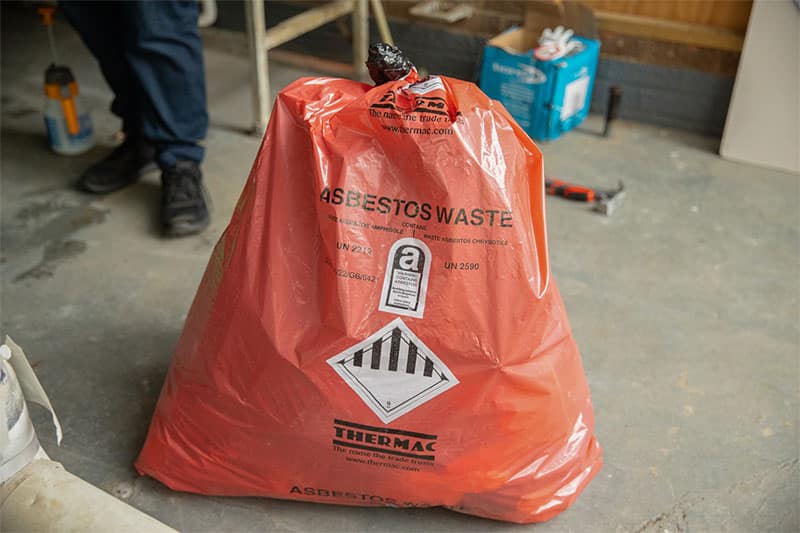How do I safely manage or remove asbestos in a building?
Knowing how to properly manage asbestos is crucial to keeping yourself and everyone else on the premises safe. That includes the safety of residents, employees, contract workers, and even visitors and passersby.
In their complete, undamaged state, asbestos-containing materials (ACMs) don’t pose an immediate threat. However, once an ACM is disturbed in some way, it can release undetectable toxic fibres. Once inhaled or ingested, those fibres adhere to the lungs, and they can cause cancer and other life-threatening diseases years in the future.
Understanding the ins and outs of asbestos management ensures you’ll stay legally compliant while protecting the health of anyone who comes in or near the building.
In this article, we’ll provide detailed guidance about the safe management of asbestos, including what to do if you need to plan for asbestos removal. Whether you’re a homeowner, commercial building’s duty holder, or another type of concerned individual, this information is essential for your well-being.

How do I identify the presence of asbestos in a building?
Before it was banned in 1999, asbestos was used in a vast assortment of construction materials. Determining which materials may contain asbestos isn’t easy, but it is the first step to properly managing ACMs.
Learn which ACMs are most common
Knowing which materials are most likely to contain asbestos will help you focus your efforts. Those materials include:
- Insulation
- Patching compounds
- Roofing materials
- Textured paint
- Vinyl floor tiles
Asbestos insulation can be found in many different places and materials, including the attic, boiler, ductwork, furnace, pipes, walls, and more. Spray-on insulation is also a well-known asbestos-containing material.
Steps to conduct an initial asbestos assessment
First, find out when the building was constructed and when the last renovations took place. If a building was built or last renovated prior to 2000, there’s a good likelihood that asbestos is present.
Next, perform a visual inspection to see if you can spot any ACMs. While the only way to thoroughly assess an ACM is with a lab test, you may be able to see the signs of it on your own. For example, textured paint with a popcorn-like look usually has asbestos.
You should also hire a professional asbestos surveyor who can identify ACMs and provide a risk assessment.
What are the legal requirements for managing asbestos in a building?
While the main purpose of asbestos management is to protect everyone’s health, it’s also important to stay legally compliant according to The Control of Asbestos Regulations 2012.
CAR 2012 lays out the legal guidelines for asbestos management, including:
- Who’s responsible for asbestos safety in a commercial building
- Which types of asbestos removal require a licence
- Reporting timelines and processes
- Proper protective equipment to keep workers safe
- Disposal methods to avoid environmental contamination
The Health and Safety Executive provides further information about asbestos regulations, including practical advice for staying compliant and the different types of asbestos training programs that are available.
Asbestos compliance and documentation
It’s important to keep, request, and maintain asbestos documentation, including survey results, risk assessments, and the building’s asbestos register. Furthermore, any information about asbestos in a building should be communicated with tenants, employees, and contractors. They should have easy access to all asbestos documentation, too.
Penalties for non-compliance with CAR 2012 range from high fines to a prison sentence. Fines can be as high as £20,000, and imprisonment can last for several months.
How can I safely manage asbestos without removal?
There are various ways to manage asbestos, ranging from avoiding ACMs that are in good condition to removing damaged materials that are creating a health risk.
Understanding your management options
In some cases, your safest option is to manage asbestos in place. This means that instead of removing the ACM, you leave it where it is and take steps to protect it from disturbance.
This could mean clearly marking intact ACMs so nobody accidentally damages them. Or, if there’s slight damage to an ACM but it can be fixed with encapsulation, that may be a less-risky alternative to removal. Enclosing ACMs is also an option so they don’t get unknowingly disturbed during regular activities.
In other cases, removal may be the best option. For example, severely damaged asbestos that cannot be safely repaired should be completely removed.
Steps for safe asbestos management
It’s important to create an asbestos management plan, which includes the duty holder’s name, the asbestos register, your monitoring schedule for checking ACMs, and more. Whenever the state of an ACM changes or building activities threaten to disturb and ACM, the asbestos management plan should be updated. In the event that an ACM deteriorates or is damaged, it’s best to consult with an asbestos expert to determine if removal is necessary.
When should asbestos be removed?
There are two scenarios that mean the ACMs should be removed from the premises:
- The asbestos material is damaged, and it’s beyond being repaired, enclosed or encapsulated safely.
- An ACM in any condition could be damaged during a planned home renovation project.
If either situation is occurring, asbestos removal is the only reasonable option, and it should always be handled by a professional.
The professional asbestos removal process
There are several steps to the asbestos removal process. Here’s what to expect:
- ACMs will be located and tested
- An asbestos expert will create a removal plan
- The work area will be clearly marked and contained
- Air-filtering devices will be set up within the work area
- Various methods will be used to safely remove and dispose of ACMs
- After removal, the work area will be cleaned and tested for reoccupation
Your asbestos contractor can walk you through each step and let you know what to expect. You may need to vacate the premises while the work is performed or relocate to another area of the building to avoid being exposed to asbestos fibres.
How do I choose a qualified asbestos removal contractor?
While only some types of asbestos removal projects require a licence, any asbestos expert you hire should have the proper licensing, regardless of what’s needed for your specific asbestos job. Furthermore, the asbestos contractors you hire should have up-to-date UKATA-certified training at the highest level.
You’ll also want to check that they’re properly insured. Don’t hesitate to ask for references, either, and read reviews online. It’s also smart to look up the individual or company on Google to see if they’ve run into legal compliance issues in the past.
Before you opt to hire them, it’s also OK to find out about their asbestos removal process and the different safety measures they take.
If you’re not well-versed in asbestos management and you’ve never hired a contractor before, it’s difficult to know if the advice they’re giving you is accurate. You can always speak with another company and get a quote, then compare the information from both companies to see if there are any major discrepancies.
What are the steps to ensure ongoing asbestos safety post-removal?
After asbestos removal, but before that part of the building is safe to return to, thorough air-quality testing must be performed by the asbestos team. They should provide you with a clearance certificate that shows it’s safe to reoccupy the work area.
If some ACMs were managed in place instead of removed, you’ll need to keep the asbestos register up to date. This means regularly checking on the ACMs to see if there’s been any change and updating the register and asbestos management plan accordingly.
It’s also necessary to have clear communication with others in the building, along with future contractors and occupants. Let them know the state of asbestos on the premises, how they can stay safe, and where to find detailed information about the building’s asbestos management plan.
Final thoughts about asbestos management
Identifying ACMs and assessing their condition is the first step to safe asbestos management. From there, an asbestos management plan should be written up. Next, the necessary safety measures should be taken, whether that’s making others aware of where ACMs are located, encapsulating ACMs to keep them safe, or arranging for professional removal.
It’s crucial that you comply with legal regulations, both to avoid punishment and to protect yourself and others from life-threatening diseases. It’s always recommended that you use professional asbestos services, regardless of how minor the removal job seems to be.
To speak with an expert about your asbestos management plan, contact us today.

Written by Jess Scott
Jess Scott has been an all-round asbestos consultant since 1996. That’s nearly 3 decades of asbestos knowledge. He spends his time sharing that knowledge with the team at Oracle and with their clients. Jess's goal is, and always has been, to use my expertise in helping people to comply with the law. This legal compliance ultimately helps to protect everyone from the harmful effects of asbestos. Jess has acted as an asbestos expert witness in legal cases and is involved in many asbestos educational activities throughout the UK.
